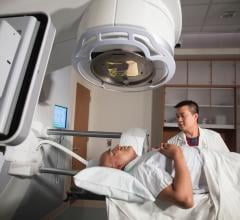
August 6, 2009 - In comparison to a cohort of patients treated by conventional radiation techniques, image-guided intensity-modulated RT (IG-IMRT) was feasible for biliary tract tumors, and the median survival was nearly double that in the group treated with conventional RT.
This study is the first clinical outcomes of biliary tract cancers treated with IG-IMRT, warranting further investigation in prospective clinical trials.
Biliary tract lesions are comparatively rare neoplasms, with ambiguous indications for radiotherapy. The purpose of the study was to report the clinical results of a single-institution biliary tract series treated with modern radiotherapeutic techniques, and detail results using both conventional and image-guided intensity-modulated radiation therapy (IG-IMRT).
In the stidy, 24 patients with primary adenocarcinoma of the biliary tract (gallbladder and extrahepatic bile ducts) were treated by IG-IMRT from 2001 to 2005. To compare outcomes, data from a sequential series of 24 patients treated between 1995 and 2005 with conventional radiotherapy (CRT) techniques were collected as a comparator set. Demographic and treatment parameters were collected. Endpoints analyzed included treatment-related acute toxicity and survival.
The results showed a median estimated survival for all patients completing treatment was 13.9 months. A statistically significant higher mean dose was given to patients receiving IG-IMRT compared to CRT, 59 vs. 48 Gy. IGIMRT and CRT cohorts had a median survival of 17.6 and 9.0 months, respectively. Surgical resection was associated with improved survival. Two patients (4 percent) experienced an RTOG acute toxicity score > 2. The most commonly reported GI toxicities (PRTOG Grade 2) were nausea or diarrhea requiring oral medication, experienced by 46 percent of patients.
Source: Radiother Oncol. 2009 Aug 1;92(2):249-254, CD Fuller, ND Dang, SJ Wang, P Desai, M Choi, CR Thomas, M Fuss.
For more information: www.oncologystat.com


 December 02, 2025
December 02, 2025 









